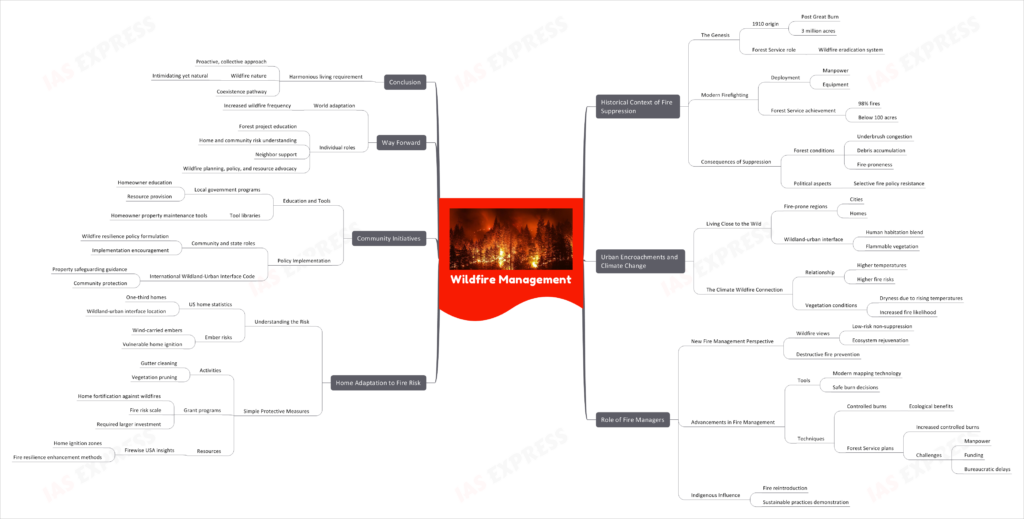Wildfire Season- How can we live with these disasters?
From Current Affairs Notes for UPSC » Editorials & In-depths » This topic
IAS EXPRESS Vs UPSC Prelims 2024: 85+ questions reflected
Humans, conditioned to fear the destructive power of wildfires, have tried suppressing them for over a century. However, evolving circumstances and understanding suggest that our approach towards wildfire needs significant change.

Historical Context of Fire Suppression
- The Genesis:
- The current approach traces its origin to around 1910, post the Great Burn which consumed about 3 million acres across several regions.
- This led the Forest Service to create a system focused on eradicating wildfire.
- Modern Firefighting:
- Presently, an extensive arsenal of manpower and equipment is deployed when fires erupt.
- The Forest Service has a record of extinguishing 98% of wildfires before they span 100 acres.
- Consequences of Suppression:
- Continuous suppression has resulted in forests being congested with underbrush and debris, making them prone to fires.
- Political resistance against adopting a more selective fire policy.
Urban Encroachments and Climate Change
- Living Close to the Wild:
- Many cities and homes have been established in fire-prone regions, specifically in the wildland-urban interface.
- This zone is a blend of human habitation and flammable vegetation.
- The Climate Wildfire Connection:
- A direct relationship: Higher temperatures equate to higher risks of fires.
- Rising temperatures contribute to drying out vegetation, increasing the likelihood of fires.
Role of Fire Managers
- New Fire Management Perspective:
- Not all wildfires should be suppressed, especially those posing low-risk.
- Such fires can rejuvenate ecosystems and prevent larger, more destructive fires.
- Advancements in Fire Management:
- Modern mapping technology aids in deciding which forests can be allowed to burn safely.
- Controlled burns (prescribed burning) provide many ecological benefits.
- The Forest Service plans to increase its controlled burning but faces challenges in manpower, funding, and bureaucratic delays.
- Indigenous Influence:
- Indigenous groups are reintroducing fire to landscapes, showcasing sustainable practices.
Home Adaptation to Fire Risk
- Understanding the Risk:
- Over one-third of US homes are located in the wildland-urban interface.
- Wind-carried embers can ignite vulnerable spots in homes located miles away from the actual fire.
- Simple Protective Measures:
- Cleaning gutters, pruning close vegetation, and other low-effort activities can significantly mitigate risks.
- Grant programs aim to fortify homes against wildfires, but the scale of fire risk necessitates a larger investment.
- Resources like Firewise USA offer insights on “home ignition zones” and methods to enhance fire resilience in properties.
Community Initiatives
- Education and Tools:
- Many local governments have wildfire programs to educate homeowners and provide them with resources.
- “Tool libraries” have been established to offer tools to homeowners for property maintenance.
- Policy Implementation:
- States and communities are urged to formulate and implement forward-looking wildfire resilience policies.
- International Wildland-Urban Interface Code offers guidance on safeguarding properties and communities.
Way Forward
Adapting to a world where wildfire occurrences are more frequent implies collective effort. Each individual must:
- Educate themselves on forest projects.
- Understand and address home and community risks.
- Support neighbors.
- Push for effective wildfire planning, policy, and resources.
Conclusion
Living harmoniously in a world with wildfires requires a proactive, collective approach. While wildfires can be intimidating, they are also a natural part of our ecosystem. Acknowledging this dual nature and taking steps towards coexistence is the path ahead.
Practice Question for Mains
Given the looming challenges posed by wildfires, critically examine its implications for wildfire management. Suggest adaptive and mitigative strategies. (250 words)
If you like this post, please share your feedback in the comments section below so that we will upload more posts like this.

